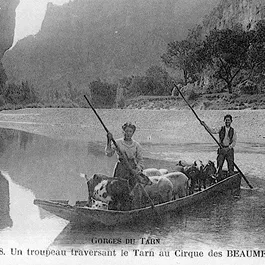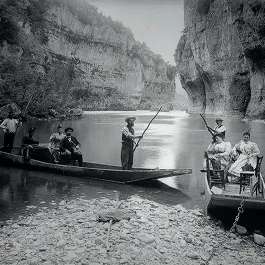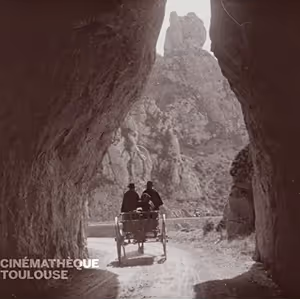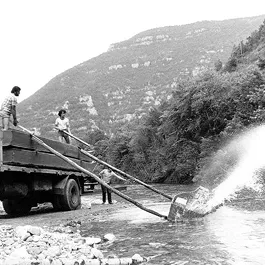The history of the boatmen
An activity rooted in the canyon for centuries
The history of boatmen and boats in the Gorges du Tarn is closely linked to the rugged geography of the region. Since the 14th century, boats have been the main means of transport in the canyon. Each village has wooden boats of various shapes, used to connect villages, work in the vineyards or fish with nets or cast nets.
At the end of the 19th century, the first tourists discovered the Gorges thanks to the Paris-Béziers railway line. Hotels appeared in the villages and the first tourist descents were organised. At that time, the boats were not yet adapted for tourism, and ladies in full dress could be seen sitting on simple kitchen chairs on board the boats.
Key dates
Before 1875

Boats were the only means of transport in the Gorges du Tarn, as there were no roads at the time. The inhabitants used them to transport livestock and grapes, or to travel from one village to another.
1875

The Paris-Béziers railway line brings the first tourists to the Gorges du Tarn. The boats are adapted to accommodate them, and the descent – as well as the ascent – is done using poles.
1905

The Tarn Gorges road is finally complete, making travel easier and the canyon accessible. Boats are no longer the only means of transport, but they are still used for fishing and tourist trips.
1952

Creation of the Bateliers cooperative. The boatmen are no longer employed by hotels and have formed a cooperative (SCOP). Still active today, it has eight permanent employees and up to twenty-three during the summer season.
A journey through time along the Tarn
The first images filmed from a boat (early 20th century)
Discover an exceptional document that plunges us into the heart of the history of the Gorges du Tarn: a mini-film shot at the beginning of the 20th century, with a camera mounted on a traditional boat. These rare images bear witness to the timeless beauty of the river and the life of the boatmen of yesteryear. More than just a visual record, this archive transports the viewer on a unique journey to discover the landscapes and traditions that still shape the soul of the Tarn today.
